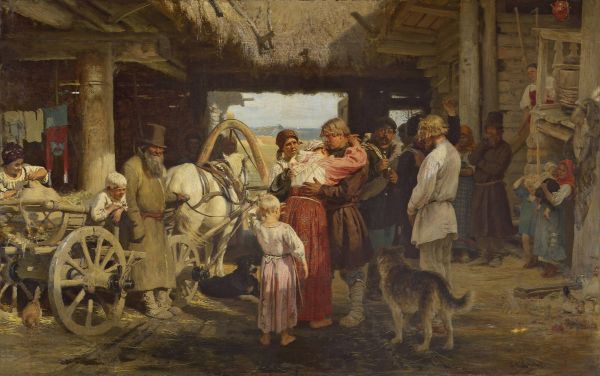|
|
Seeing off a Recruit. 1879

Repin Ilya,
Oil on canvas
143 х 225
State Russian Museum
Annotation
In the end of 1870-s, after returning home from a foreign trip, Repin started to pay special attention to the life of peasants. This interest was reflecting in his major work on the topic – Seeing off a Recruit. The painting was created under the influence of the Russo-Turkish War of 1877-1878. The artist depicted one of the most touching moments – a farewell bid by the family to a young recruit. The scene takes place in a typical country yard that the painter found in Bykovo village in the vicinity of Moscow. All feelings of the characters are expressed in a simple, clear, and sincere way. The artist thoroughly prepared for this panting and created numerous studies for it. The work was being painted in 1877-1879 in Moscow and in summer – also in the vicinity of Moscow, in Abramtsevo, a homestead of the famous art patron Savva Mamontov where famous artists and musicians used to meet. Immediately after the painting was finished it was purchased by the President of the Academy of Arts, Grand Duke Vladimir Alexandrovich.
Author's Biography
Repin Ilya
Repin, Ilya Yefimovich
1844, Chuguyev (Kharkiv Province) - 1930, Kuokkala (Finland)
Painter, draughtsman, watercolour painter, portraitist, history painter. Studied under local artists at the School of Military Topography in Chuguyev (1854-57), under Ivan Kramskoi at the School of Drawing, Society for the Encouragement of Artists (1863) and at the Imperial Academy of Arts (1864-71). Fellow of the Imperial Academy of Arts in Italy and France, lived mostly in Paris (1873-76). Academician (1876). Professor, full member of the Imperial Academy of Arts (1893). Member of the Society of Travelling Art Exhibitions (1878, exhibited from 1874). Headed a studio at the Higher School of Art, Imperial Academy of Arts (1894-1907) and taught at Princess Maria Tenisheva''s school of art (1895-98). Lived in St Petersburg and Moscow, settled in Kuokkala (1900).

